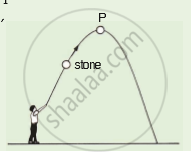Advertisements
Advertisements
Question
Explain the transformation of energy in the following cases :
(i) A ball thrown upwards.
(ii) A stone dropped from the roof of a building.
Solution
(i) When a ball is thrown upwards, its kinetic energy at the thrower's hand is transformed into potential energy at the maximum height. As the stone continues to move upwards, its potential energy gradually increases, but its kinetic energy decreases as velocity of the stone decreases.
(ii) When a stone is dropped from a height its potential energy at the height is transformed into kinetic energy on reaching the ground. As the stone descends, its potential energy gradually decreases and its kinetic energy increases.
APPEARS IN
RELATED QUESTIONS
State the condition under which the mechanical energy is conserved.
A stone of mass 500 g is thrown vertically upwards with a velocity of 15 m/s. Calculate:
- the potential energy at the greatest height,
- the kinetic energy on reaching the ground, and
- the total energy at its half-way point.
What kind of energy is possessed by the following?
A compressed spring ____________.
What kind of energy is possessed by the following?
A stretched rubber band _____________
Fill in the blank with suitable word :
The sum of the potential and kinetic energies of a body is called __________ energy.
Two bodies having equal masses are moving with uniform speeds of v and 2v respectively. Find the ratio of their kinetic energies.
A ball of mass 0.5 kg slows down from a speed of 5 m/s so that of 3 m/s. Calculate the change in kinetic energy of the ball. State your answer giving proper units.
A stone is thrown upwards as shown in the diagram. When it reaches P, which of the following has the greatest value of the stone?
A bulb lights up when connected to a battery. State the energy change which takes place :
A body of mass 10 kg at rest is acted upon simultaneously by two forces 4 N and 3 N at right angles to each other. The kinetic energy of the body at the end of 10 s is
